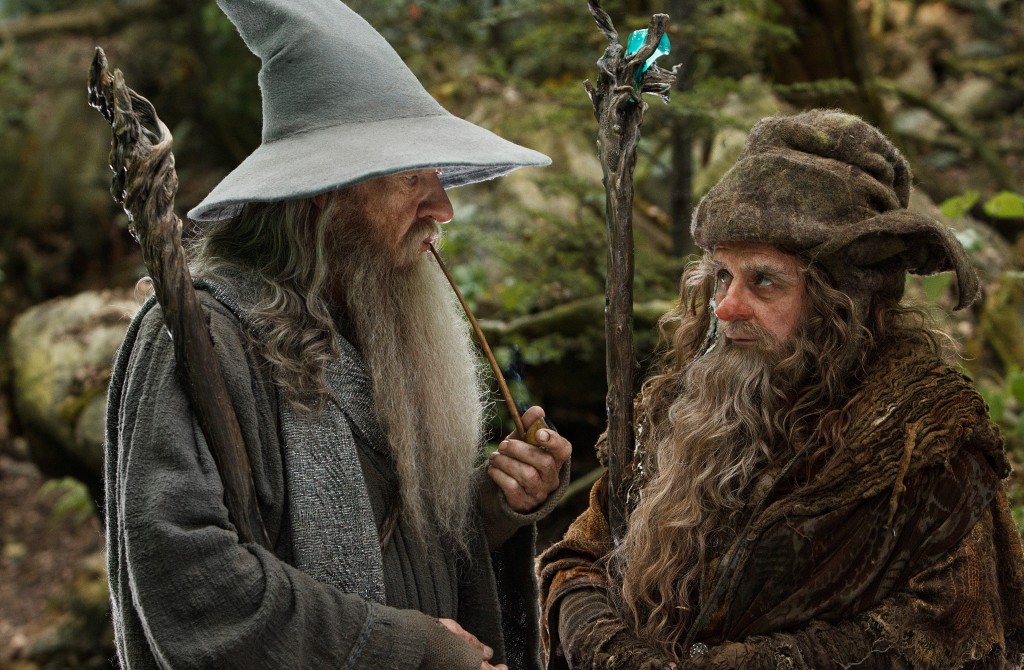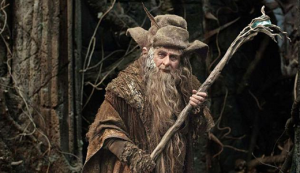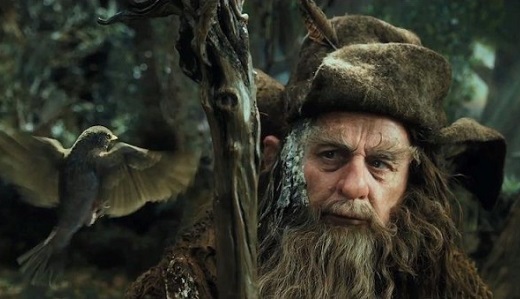Who was Radagast the Brown?
A member of the Order of wizards, Radagast was a Maia sent to Middle-earth to aid its inhabitants against the growing threat of Sauron. During the Council of Elrond in The Fellowship of the Ring, Gandalf says of him:
“Radagast is, of course, a worthy Wizard, a master of shapes and changes of hue; and he has much lore of herbs and beasts, and birds are especially his friends.”
Radagast was a powerful Maia in his own way. Communicating with animals and having the ability to change shapes and create illusions are certainly essential qualities.
He also dwelt in Rhosgobel, “near the Southern borders of Mirkwood” (The Hobbit – Chapter 7,“Queer Lodgings”).
Don’t be fooled by his foolishness …
Radagast’s only scene in Tolkien’s world appears in The Lord of the Rings, in the form of a flashback.
Gandalf, on his way to Isengard, meets Radagast who delivers a message. It is the Brown wizard who informs Gandalf of the Nazgûl’s reappearance as riders in black, searching for “The Shire,” and it is he who delivers Saruman’s message for assistance.
Of course, Radagast had no knowledge of Saruman’s betrayal and was simply acting as a messenger between friends.

We’ve already established that he’s a master of birds and animals and indeed, in his meeting with Gandalf, he was ordered to:
“Send out messages to all the beasts and birds that are your friends. Tell them to bring news of anything that bears on this matter to Saruman and Gandalf” (The Fellowship of the Ring, Book II: Chapter 2, ‘The Council of Elrond’).
Clearly, Radagast was an important element in the gathering of information through the natural world; and he still was a Maia, after all.
Radagast in The Two Towers? The most fascinating mystery …
Undoubtedly, what makes Radagast such a fantastic character (apart from everything else) is his possible appearance early on in The Two Towers.
In one of the most ambiguous scenes from The Lord of the Rings, a tired trio of hunters (Aragorn, Legolas, and Gimli) find themselves resting for the night on the borders of Fangorn Forest:
“Suddenly Gimli looked up, and there just on the edge of the fire-light stood an old bent man, leaning on a staff, and wrapped in a great cloak; his wide-brimmed hat was pulled down over his eyes.”
(The Two Towers, Book III: Chapter 2 – ‘The Riders of Rohan’)
 The old man doesn’t speak and as Aragorn tries to approach him, “the old man was gone. There was no trace of him to be found near at hand…” Soon after, their horses cry out and run away.
The old man doesn’t speak and as Aragorn tries to approach him, “the old man was gone. There was no trace of him to be found near at hand…” Soon after, their horses cry out and run away.
Gimli quickly arrives to the conclusion that it must have been Saruman, but Aragorn argues against it: “this old man had a hat not a hood” – unlike the wizard’s usual hooded appearance.
In the following chapters, when the three meet Gandalf (returned now as the White), Gimli asks him the question we have all been wanting to ask.
“Was it you, Gandalf, or Saruman that we saw last night?”
‘You certainly did not see me,’ answered Gandalf, ‘therefore I must guess that you saw Saruman.”
(The Two Towers, Book III: Chapter 5 – ‘The White Wizard’)
The answer seems pretty straight forward, but we can’t deny the element of the “hat” compared to the “hood,, which Aragorn made reference to. Furthermore, why would Saruman be interested in three members of the Fellowship, who had nothing to do with the One Ring directly – unlike hobbits?
A theory supported by many, points towards the idea that this individual was none other than Radagast. If not himself, perhaps one of his mentioned “illusions,” a rare glimpse of this character leaving Rosghobel and taking part in the events of the War of the Ring – perhaps watching over the characters.
A figure who remains hidden in the shadows, but is always present.
 A silent guardian…
A silent guardian…
As to the horses running away, we learn that they meet Shadowfax later on, but in re-reading the scene from ‘The Riders of Rohan’ chapter, the horses run away at the sight of the old man. Perhaps they recognized Radagast and rather ran towards him, as their friend (and were later on joined by Shadowfax himself).
A tantalizing moment that may shed a ray of light on this allusive character.
“Perhaps you have heard of my good cousin Radagast” – but was he really?
So says Gandalf to a cautious Beorn in The Hobbit, as the wizard seeks help from the shapeshifter; and it is the only time in the book where the name of Radagast is ever brought up.
What is curious here is the use of the word “cousin.”
Most likely, it is merely a way for Gandalf to refer to a friend. But why say “cousin” when he could have used any other term: “friend”, “companion” …anything.
Whether “cousin” should be taken literally or not, is up to the readers to decide. After all, in The Silmarillion, the Valar had spouses and a Maia (Melian) wedded an elf king (Thingol), from whom came the descendants of Eärendil.
Relatives among Maia, therefore, may have been quite possible …
But once again, the choice of speculation lies with the reader–an aspect that makes Tolkien’s Middle-earth such a hauntingly beautiful and attractive place.
(Article originally posted on A Tolkienist’s Perspective)


